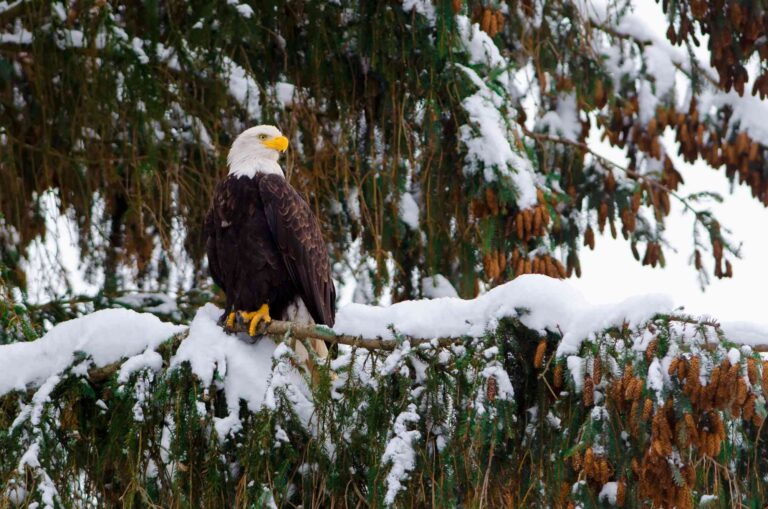
A soaring, majestic silhouette on the skyline, the bald eagle has not only been the national symbol of the United States for more than 240 years, but it is also a symbol of how the Endangered Species Act can save wildlife from extinction.
The bald eagle is the only eagle solely indigenous to North America. A species of sea eagle, fish are a major part of its diet, although it will also eat waterfowl, small mammals and carrion. They are found in wetlands, near rivers and lakes, or on the coast throughout North America. Its wingspan ranges from 72 to 90 inches (182-228 cm) and they weigh around 10 to 14 pounds (4.5-6.4 kg) when adults. This makes them one of the largest birds of prey resident in North America (the Californian condor is the largest). They get their name from the old English world “balde” meaning “white-headed.”
The bald eagle has been culturally important to Native Americans for millennia, but it started to be used as a symbol for the United States during the American Revolution, eventually becoming the official symbol of the U.S. in 1782. In the 18th century, it was estimated that there were up to half a million bald eagles in North America. However, numbers dropped catastrophically, to a mere 412 nesting pairs in the lower 48 states, by the 1950s.
Despite being a symbol of the nation, bald eagles suffered from public prejudice, with many people wrongly believing that the eagles killed lambs and other newborn livestock—even that they attacked young children—leading to a high level of persecution and the decline of the eagle in the U.S. The decrease and fragmentation of the wetland habitats preferred by eagles was also a major issue.
However, bald eagles gained some protection in 1918 under the Migratory Bird Treaty Act (MBTA) and again in 1940 when the threat of their extinction led to Congress passing the Bald Eagle Protection Act (later amended to become the Bald and Golden Eagle Protection Act), which prohibited killing eagles or taking their eggs. Unfortunately, the widespread use of the pesticide DDT in the 1940s and 50s led to the decimation of eagle and other bird populations. One of the effects of this pesticide is thinning of eggshells, leading to a high level of chick mortality. Rachel Carson’s famous book Silent Spring publicized the threat that DDT posed both to humans and wildlife. And, thanks to pressure from the public and scientists, its use in agriculture was banned in the U.S. in 1972.
The bald eagle population in the U.S. south of the 40°N parallel (encompassing eagles in Colorado and southern coastal states) was listed as endangered under the Endangered Species Preservation Act U.S. in 1967 —the predecessor to the Endangered Species Act (ESA). The bald eagle was subsequently listed as endangered or threatened in all of the lower 48 states under the ESA in 1978. Amendments to the Bald and Golden Eagle Act in 1972 also added more protections for the eagles, including protecting them from disturbance and increasing penalties for those breaking the law.
Listing the species as endangered or threatened led to the U.S. government and partners launching a number of initiatives to help the eagle recover. These included captive breeding programs and the reintroduction of eagles into historic habitats, shielding critical eagle habitat from development and degradation, and protecting eagle nests during breeding season. Eagles began to bounce back, and in 1995 the entire portion of the endangered population in the lower 48 states was downlisted to “threatened” under the ESA. By 2007, there were nearly ten thousand breeding pairs in the lower 48 states, and they were removed from the list of endangered and threatened wildlife as they were considered to have recovered. In 2021, the U.S. Fish and Wildlife Service estimated that the bald eagle population in the lower 48 states (for the period 2018-2019) totaled 316,700 individuals, of which 71,467 were breeding pairs.
The recovery of the bald eagle is a conservation success story. A critical combination of effective laws, enforcement, collaboration between the U.S. government and partners, and public support led to the bald eagle clawing back from the brink of extinction to a flourishing national population.
However, even though the eagle is no longer considered to be legally threatened, they still face many human-caused threats including lead pollution (from gun shot and fishing weights), poisoning, collision with motor vehicles and wind turbines, and electrocution by power lines. We must ensure that we protect the eagle against these threats and reckless development in their habitats.
Defenders has fought against attempts to weaken the MBTA and the ESA, and we have also promoted restrictions on lead ammunition in order to reduce the amount of the toxic metal reaching species like the eagle.
In addition, we promote “Smart from the Start” renewable energy siting, to keep wind farms out of migratory pathways and promote innovative technology that deters eagles and other birds from turbines.


